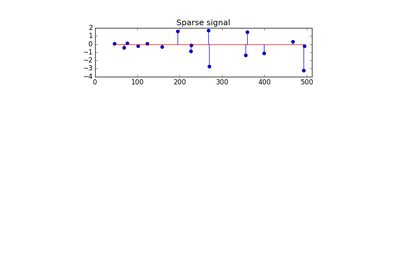sklearn.linear_model.OrthogonalMatchingPursuit¶
-
class
sklearn.linear_model.OrthogonalMatchingPursuit(n_nonzero_coefs=None, tol=None, fit_intercept=True, normalize=True, precompute='auto')[source]¶ Orthogonal Matching Pursuit model (OMP)
Parameters: n_nonzero_coefs : int, optional
Desired number of non-zero entries in the solution. If None (by default) this value is set to 10% of n_features.
tol : float, optional
Maximum norm of the residual. If not None, overrides n_nonzero_coefs.
fit_intercept : boolean, optional
whether to calculate the intercept for this model. If set to false, no intercept will be used in calculations (e.g. data is expected to be already centered).
normalize : boolean, optional, default False
If True, the regressors X will be normalized before regression. This parameter is ignored when fit_intercept is set to False. When the regressors are normalized, note that this makes the hyperparameters learnt more robust and almost independent of the number of samples. The same property is not valid for standardized data. However, if you wish to standardize, please use preprocessing.StandardScaler before calling fit on an estimator with normalize=False.
precompute : {True, False, ‘auto’}, default ‘auto’
Whether to use a precomputed Gram and Xy matrix to speed up calculations. Improves performance when n_targets or n_samples is very large. Note that if you already have such matrices, you can pass them directly to the fit method.
Read more in the :ref:`User Guide <omp>`. :
Attributes: coef_ : array, shape (n_features,) or (n_features, n_targets)
parameter vector (w in the formula)
intercept_ : float or array, shape (n_targets,)
independent term in decision function.
n_iter_ : int or array-like
Number of active features across every target.
See also
orthogonal_mp,orthogonal_mp_gram,lars_path,Lars,LassoLars,decomposition.sparse_encodeNotes
Orthogonal matching pursuit was introduced in G. Mallat, Z. Zhang, Matching pursuits with time-frequency dictionaries, IEEE Transactions on Signal Processing, Vol. 41, No. 12. (December 1993), pp. 3397-3415. (http://blanche.polytechnique.fr/~mallat/papiers/MallatPursuit93.pdf)
This implementation is based on Rubinstein, R., Zibulevsky, M. and Elad, M., Efficient Implementation of the K-SVD Algorithm using Batch Orthogonal Matching Pursuit Technical Report - CS Technion, April 2008. http://www.cs.technion.ac.il/~ronrubin/Publications/KSVD-OMP-v2.pdf
Methods
decision_function(\*args, \*\*kwargs)DEPRECATED: and will be removed in 0.19. fit(X, y)Fit the model using X, y as training data. get_params([deep])Get parameters for this estimator. predict(X)Predict using the linear model score(X, y[, sample_weight])Returns the coefficient of determination R^2 of the prediction. set_params(\*\*params)Set the parameters of this estimator. -
__init__(n_nonzero_coefs=None, tol=None, fit_intercept=True, normalize=True, precompute='auto')[source]¶
-
decision_function(*args, **kwargs)[source]¶ DEPRECATED: and will be removed in 0.19.
Decision function of the linear model.
Parameters: X : {array-like, sparse matrix}, shape = (n_samples, n_features)
Samples.
Returns: C : array, shape = (n_samples,)
Returns predicted values.
-
fit(X, y)[source]¶ Fit the model using X, y as training data.
Parameters: X : array-like, shape (n_samples, n_features)
Training data.
y : array-like, shape (n_samples,) or (n_samples, n_targets)
Target values.
Returns: self : object
returns an instance of self.
-
get_params(deep=True)[source]¶ Get parameters for this estimator.
Parameters: deep : boolean, optional
If True, will return the parameters for this estimator and contained subobjects that are estimators.
Returns: params : mapping of string to any
Parameter names mapped to their values.
-
predict(X)[source]¶ Predict using the linear model
Parameters: X : {array-like, sparse matrix}, shape = (n_samples, n_features)
Samples.
Returns: C : array, shape = (n_samples,)
Returns predicted values.
-
score(X, y, sample_weight=None)[source]¶ Returns the coefficient of determination R^2 of the prediction.
The coefficient R^2 is defined as (1 - u/v), where u is the regression sum of squares ((y_true - y_pred) ** 2).sum() and v is the residual sum of squares ((y_true - y_true.mean()) ** 2).sum(). Best possible score is 1.0 and it can be negative (because the model can be arbitrarily worse). A constant model that always predicts the expected value of y, disregarding the input features, would get a R^2 score of 0.0.
Parameters: X : array-like, shape = (n_samples, n_features)
Test samples.
y : array-like, shape = (n_samples) or (n_samples, n_outputs)
True values for X.
sample_weight : array-like, shape = [n_samples], optional
Sample weights.
Returns: score : float
R^2 of self.predict(X) wrt. y.
-
set_params(**params)[source]¶ Set the parameters of this estimator.
The method works on simple estimators as well as on nested objects (such as pipelines). The latter have parameters of the form
<component>__<parameter>so that it’s possible to update each component of a nested object.Returns: self :
-


